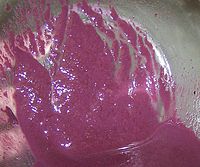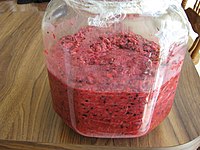Lees (fermentation)


Leesare deposits of deadyeastor residual yeast and other particles that precipitate, or are carried by the action of "fining",to the bottom of avatofwineafterfermentationandaging.The same while brewingbeerat a brewery is known astrub– the same fromsecondary fermentationof wine and beer are theleesor equally, as to beer only,dregs.This material is the source for most commercialtartaric acid,which is used in cooking and inorganic chemistry.[1]
Normally, the wine is transferred to another container (racking), leaving this sediment behind. Some wines (notablyChardonnay,Champagne,andMuscadet) are sometimes aged for a time on the lees (a process known assur lie), leading to a distinctive yeasty aroma and taste. The lees may be stirred (French:bâtonnage) for uptake of their flavour.
The lees are an important component in the making ofripasso,where the leftover lees fromAmaroneare used to impart more flavour and colour to partially agedValpolicella.[citation needed]
Fu gian red wine chickenis made from rice wine lees.
Sur lie
[edit]Sur lieliterally translates fromFrenchas 'on lees'.Sur liewines are bottled directly from the lees without racking (a process for filtering the wine). In the case of great Chardonnay, such asMontrachet,this adds a toasty, nutty "hazelnut" quality and additional depth and complexity. Chemically, this can alter the oak flavour molecules, increasing the integration, and making the oak seem less obtrusive to the palate. This is desirable because oaktanninsare polyphenolic acids, and can be harsh. This process can also give an added freshness and creaminess to the wine, and improvecolorand clarity.[clarify]Muscadet is made in this fashion. The effect of the lees during bottle fermentation for at least 18 months on Champagne is considerable. The "bready" toasty notes associated with some of the greatest sparkling wines made are the result ofsur lieaging.[2]
Other uses
[edit]Beer on an element of lees (residual sediment) is also sold, such as many
- Trappist beers
- UnibroueQuebec, Canada-based ales/beers
- Real alesof older styles (notIndia Pale Ale)
- Weissbiers
Kombuchacan also be brewedsur lie.
Lees can also be distilled to produceHefebrand,or "lees spirit", an alcoholic beverage containing a minimum of 38% alcohol by volume.[3]
Light lees protocol
[edit]In a process in which yeast is added to wine that has completed primary fermentation, this secondary yeast addition typically remains in the wine from 2–8 weeks, depending on the winemaker's goals. The yeast is stirred (bâtonage) frequently, and racked when the protocol is complete. Also known assecondary autolysis,a light lees protocol releases additional mannoproteins andpolysaccharidesthat can influence the flavour, tannins, and acidity of the wine.
See also
[edit]References
[edit]- ^Kassaian, Jean-Maurice (2000). "Tartaric Acid".Ullmann's Encyclopedia of Industrial Chemistry.pp. 671–678.doi:10.1002/14356007.a26_163.ISBN3527306730.
- ^Robinson, Jancis; Harding, Julia, eds. (2015).The Oxford Companion to Wine.Oxford University Press. p. 711.ISBN978-0-19-870538-3.
- ^Regulation (EU) No 2019/787 of 17 April 2019 on the definition, description, presentation and labelling of spirit drinks, the use of the names of spirit drinks in the presentation and labelling of other foodstuffs, the protection of geographical indications for spirit drinks, the use of ethyl alcohol and distillates of agricultural origin in alcoholic beverages, and repealing Regulation (EC) No 110/2008,§12
